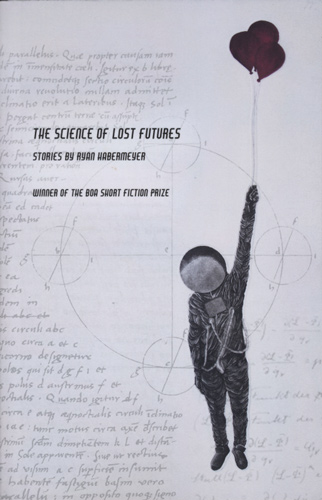The Science of Lost Futures
When first opening The Science of Lost Futures, I was already familiar with some of Ryan Habermeyer’s works, so I knew what to expect. Or so I thought. Habermeyer’s mysterious fiction defied all my expectations. This collection of stories pulled me into the strange world where a woman can turn into a snow leopard, people admire a giant foot, and turkeys take over a house. These strange occurrences, however, become fantastic circumstances for Habermeyer to explore human relationships. In this collection of witty stories, Ryan Habermeyer places humans in bizarre and sometimes absurd conditions which creates a rich world with relationships at its center.
When first opening The Science of Lost Futures, I was already familiar with some of Ryan Habermeyer’s works, so I knew what to expect. Or so I thought. Habermeyer’s mysterious fiction defied all my expectations. This collection of stories pulled me into the strange world where a woman can turn into a snow leopard, people admire a giant foot, and turkeys take over a house. These strange occurrences, however, become fantastic circumstances for Habermeyer to explore human relationships. In this collection of witty stories, Ryan Habermeyer places humans in bizarre and sometimes absurd conditions which creates a rich world with relationships at its center.
The book features nineteen stories; each one of them is, paradoxically, both familiar and strange. In a way, they seem to contain magic of old fairy tales, which is not surprising considering Habermeyer’s area of expertise: European folklore and fairy tales. His pieces, however, do not simply follow this genre; Habermeyer’s imagistic writing features a masterful tone, which is often ironic. The strange elements of stories are interwoven with frail humanity, offering not only a ground for exploration of human relationships, but also space for readers to contemplate them. Interestingly, Habermeyer anticipates some push back from his readers. Unlike many other writers, he uses this knowledge to his advantage: he further reaffirms the bizarre circumstances to create the absurd worlds that readers come to accept as true.
One of the most striking stories titled “The Foot” simply starts: “A foot was recovered from the inlet.” Such gripping sentences often open up his stories, setting characters’ journeys, whether physical or emotional, in motion. Habermeyer further illustrates:
The foot was enormous. It was at least twice as tall as the nearest water tower, and as wide as a cluster of neighborhood streets. It was covered in a crust of sea slime and severed above the ankle. The foot smelled of ash and cardamom, lacking the odor of decomposition one might expect. It was a left foot and we wanted to believe this was significant. The fourth toe was badly mangled, but whether it had been broken from our dragging it ashore or devoured by sharks was uncertain. The only other visible damage was a circular wound in the heel fouled with sea waste and discolored by sunlight. Most of the foot was wreathed in seaweed.
The mysterious foot spikes curiosity in visitors: children play inside of it pretending it is an alien saucer, teenagers rush to touch it ignoring all warnings, and some visitors become suddenly aware of not only “the pettiness of [their] own feet” but also “an inexplicable maze” of their own bodies “that would never be solved.” As theories about the foot’s origin continue to multiply, people are anxious to get closure and return to their everyday lives. Alas, they have not been able to find the foot’s “metaphysical significance” as it slowly washes back into the ocean.
Dealing with loss, the piece titled “Ellie’s Brood” illustrates a story of Harvey and young Ellie, a couple with a thirty-year age difference. After losing what seems to be a miraculous pregnancy, Harvey decides to breed wild turkeys. He does not have much luck at first, so he tries everything including teaching them to gobble and saving a suicidal turkey. Harvey’s efforts pay off, but suddenly his turkeys start multiplying unnaturally fast. One morning, Harvey finds Ellie in the bathroom with a mess of blood, flesh, and cracked eggs:
Ellie was bent over one of the smashed eggshells. It was only after she looked at him that he realized she had been giving a newborn poult mouth-to-mouth. The thing squirmed between her fingers like a cannoli. Harvey watched as she took a knife from her pocket and delicately nicked the throat before fitting in the straw. She blew hard. The poult’s chest puffed like a sad balloon.
As turkeys continue to reproduce, both Ellie and Harvey, in their own ways, try to deal with the sudden increase in number. Interestingly, in this story, Habermeyer not only illustrates the absurd, but he also masterfully brings to light the two people’s grief and their coping.
Habermeyer’s stories also feature different point of views. For instance, “The Fertile Yellow” is told from the point of view of a husband who undergoes different kinds of “ceremonies” to get his wife pregnant. My favorite story, “The Good Nazi Karl Schmidt,” is written from the point of view of a boy who leapfrogged from the fifth grade to the seventh. In this story, the boy’s family adopts “a stray” Nazi, who tries “to have himself punished.” Another piece, “Everything You Wanted to Know About Astrophysics but Were Too Afraid to Ask,” is presented as an address given by a young man at the 226th meeting of the American Astronomical Society. Such variety in different points of view does work on its own; it offers an interesting spin on how readers perceive protagonists and their relationships.
Habermeyer’s witty style in combination with bizarre circumstances that reveal human relationships make this collection of stories a must read. While each story surprises with unexpected and sometimes absurd exposition, it is still impossible to predict what happens next. As Habermeyer notes in his epigraph, “We are the children of chaos,” and he succeeds in taking readers to the strange world of chaos that is both absurd and real.





